The Thermaltake Toughpower GF3 850 is one of the first PSUs to fully support the ATX v3.0 spec and its challenging transient response tests, since it is equipped with a 12VHPWR connector. How it fares against similar capacity PSUs that don’t have the new PCIe connector? Read the review to find out!
Thermaltake is making a hard effort in the last few years to enter the elite of the PSU brands. Several months after the official release of ATX v3.0, it announced the GF3 line, which includes PSUs with 12VHPWR connectors that meet the strict standards of Intel’s newest design spec. I have reviewed the lowest capacity GF3 unit, with 750W max power, so the next inline is the 850W model. All GF3 models but the highest capacity ones, 1350W and 1650W, are made by Channel Well Technology. The two models above are by High Power.
The GF3 850 uses a fully modular cable design and has Gold efficiency ratings by Cybenetics and 80 PLUS. It also has a Cybenetics A- noise rating, so its average noise output stays below 30 dBA, which is the average performance for this category. TT equipped the unit with a semi-passive fan mode for lower noise output, which can be deactivated should you need the fan spinning continuously. I am not a big fan of semi-passive mode since it applies higher stress to the PSU’s internals and FDB fans. It is better to have the fan spinning at low speeds under light loads, using PWM pulses to control it. This platform uses a dedicated fan speed controller, allowing for low speeds.
- Manufacturer (OEM): CWT
- Max Power: 850W
- Cybenetics Efficiency: [115V] Gold (87-89%)
- 80 Plus Efficiency: Gold
- Noise: Cybenetics A- (25 – 30 dBA)
- Compliance: ATX12V v3.0
- Alternative Low Power Mode support: Yes
- Power 12V: 850W
- Power 5V + 3.3v: 120W
- Power 5VSB: 15W
- Cooling: 135mm Fluid Dynamic Bearing Fan (HA13525H12SF-Z)
- Semi-Passive Operation: Yes (Selectable)
- Modular Design: Yes (Fully)
- High Power Connectors: 2x EPS (2x cables), 4x PCIe 6+2 pin (2x cables), 1x PCIe 12+4 pin (600W)
- Peripheral Connectors: 12x SATA (3x cables), 4x 4-pin Molex (single cable)
- ATX/EPS Cable Length: 600/700mm
- Distance between SATA connectors: 150mm
- Distance between 4-pin Molex connectors: 150mm
- In-cable capacitors: No
- Dimensions (W x H x D): 150 mm x 85 mm x 160 mm
- Weight: 1.66 kg (3.66 lb)
- Warranty: 10 years
Product Photos
The fan grille is too restrictive. With a more open one, the average noise output could be lower. Overall, the exterior design is interesting and doesn’t look dull, which is usually the case for PSUs.
Cables
All cables are long, and the distance between the peripheral connector is adequate. The 12+4 pin PCIe connector makes the difference with competing offerings. Soon enough, though, all PSUs with more than 750W capacity will have a 12VHPWR connector. Lastly, there are no in cable caps since the PCB is large enough to host all necessary filtering caps.
The 12VHPWR connector is rated for 300W, but in reality, it reports to the graphics card 600W since both of the sense pins are grounded. Given that the PSU’s capacity is not high enough to support 600W GPUs, TT should set the sense pins accordingly to allow up to 300W max power.
Protection Features
| OCP (Cold @ 27°C) | 12V: 88.6A (125.15%), 11.978V 5V: 30.5A (138.64%), 4.997V 3.3V: 30.9A (140.45%), 3.256V 5VSB: 4.7A (156.67%), 5V |
| OCP (Hot @ 43°C) | 12V: 88.8A (125.44%), 12.025V 5V: 30.4A (138.18%), 4.999V 3.3V: 30.7A (139.55%), 3.251V 5VSB: 4.7A (156.67%), 4.995V |
| OPP (Cold @ 28°C) | 1061.34W (124.92%) |
| OPP (Hot @ 43°C) | 1067.91W (125.7%) |
| OTP | ✓ (131°C @ 12V Heat Sink) |
| SCP | 12V to Earth: ✓ 5V to Earth: ✓ 3.3V to Earth: ✓ 5VSB to Earth: ✓ -12V to Earth: ✓ |
| PWR_OK | Accurate but lower than 16ms |
| NLO | ✓ |
| SIP | Surge: MOV Inrush: NTC Thermistor & Bypass relay |
OCP at 12V and OPP are correctly set. Typically, OCP is sky-high on the minor rails. I wonder why they keep pushing OCP so high, especially at 3.3V. The rest protection features are present and working ok. There is a minor glitch in power ok signal’s hold-up time, which is slightly lower than 16ms.
Part Analysis
| General Data | – |
| Manufacturer (OEM) | CWT |
| Platform | CSZ |
| PCB Type | Double-Sided |
| Primary Side | – |
| Transient Filter | 4x Y caps, 2x X caps, 2x CM chokes, 1x MOV |
| Inrush Protection | 1x NTC Thermistor SCK-075 (7 Ohm) & Relay |
| Bridge Rectifier(s) |
2x Yangjie Electronic GBU1506 (600V, 15A @ 100°C)
|
| APFC MOSFETs |
2x STMicroelectronics STF33N60M2 (600V, 16A @ 100°C, Rds(on): 0.125Ohm)
|
| APFC Boost Diode |
1x On Semiconductor FFSP0865A (650V, 8A @ 155°C)
|
| Bulk Cap(s) |
1x Rubycon (420V, 680uF, 2,000h @ 105°C, MXE)
|
| Main Switchers |
2x On Semiconductor
|
| APFC Controller |
Champion CM6500UNX & CM03X
|
| Resonant Controller | Champion CU6901VAC |
| Topology |
Primary side: APFC, Half-Bridge & LLC converter
Secondary side: Synchronous Rectification & DC-DC converters |
| Secondary Side | – |
| +12V MOSFETs | 6x International Rectifier IRFH7004PbF (40V, 164A @ 100°C, Rds(on): 1.4mOhm) |
| 5V & 3.3V | DC-DC Converters: 2x UBIQ QN3107M6N (30V, 70A @ 100°C, Rds(on): 2.6mOhm) & 2x UBIQ QM3054M6 (30V, 61A @ 100°C, Rds(on): 4.8mOhm) PWM Controller(s): uPI-Semi uP3861P |
| Filtering Capacitors | Electrolytic: 3x Nichicon (2-5,000h @ 105°C, HD), 4x Nichicon (4-10,000h @ 105°C, HE), 1x Rubycon (2-10,000h @ 105°C, YXF), 1x Nippon Chemi-Con (4-10,000h @ 105°C, KY), 1x Nippon Chemi-Con (4-10,000h @ 105°C, KYA) Polymer: 10x Elite, 6x APAQ, 8x CapXon, 4x NIC |
| Supervisor IC | Weltrend WT7502R |
| Fan Controller | Microchip PIC16F1503 |
| Fan Model | Hong Hua HA13525H12SF-Z (135mm, 12V, 0.5A, Fluid Dynamic Bearing Fan) |
| 5VSB Circuit | – |
| Rectifier |
1x PS1045L SBR (45V, 10A)
|
| Standby PWM Controller | On-Bright OB2365T |
The OEM is Channel Well Technology, the preferred choice for many brands nowadays. The platform’s code name is CSZ, and I have met it many times so far. This is a reliable and good-performing platform equipped with good parts in this unit. The PCB is large and under-populated, allowing for optimal airflow. Nonetheless, there are no proper heatsinks on the secondary side, so the cooling fan has to spin at high speeds under harsh conditions to cool down the 12V board. The soldering quality is good, and the good caps and the fluid dynamic bearing fan won’t have a problem with the extended warranty TT provides for this product.
Load Regulation
Load regulation should be within 1% on all rails.
Ripple Suppression
Ripple suppression is great!
Transient Response
Transient response at 12V is not among the best I have seen, but it is not bad either.
Transient Response ATX 3.0 & 12VHPWR Connector Tests
The PSU passed all ATX 3.0 tests. The voltage drops at 3.3V were very close to the lower limit.
Hold Up Time
The hold-up time is among the lowest in this category. Still, it is higher than 17ms, meeting the ATX spec’s requirement. This is not the case for the power ok signal’s hold-up time, which is below 16ms.
Timings
The PSU supports Alternative Low Power Modes.
Inrush Current
Inrush current is low with 115V but pretty high with 230V input.
Efficiency Normal, Light & Super-Light Loads
Efficiency should be higher with normal loads. With light loads, the platform scores way better.
Average Efficiency 5VSB
The 5VSB rail has high enough efficiency.
Vampire Power
Vampire power is low.
Average Efficiency
The average efficiency is not high.
Average PF
The APFC converter performs well.
Average Noise
The average noise output could be lower if the fan’s speed weren’t so high at increased speeds.
Fan Noise & Speed Maps @ 28-32 °C
The fan’s passive operation doesn’t last long if you push hard the minor rails, which is what I do in these tests. Nonetheless, the fan’s noise is low with up to 460-470W loads. You will be treated with more than 30 dBA with above 720W loads, and the 40 dBA mark is passed with more than 825W.
Overall Performance
The overall performance is close to competing offerings by be quiet! and Cooler Master. The XPG Core Reactor is a bit further, and the EVGA 850 G7 and Corsair RM850x are notably higher in this chart. With a tighter load regulation at 12V and better transient response on the same rail, the GF3 850 would be closer to the high-end competition.
Epilogue
Thermaltake is among the first to offer fully ATX 3.0 and PCIe 5.0 ready PSUs through its GF3 line. The 750W and 850W units successfully passed the strict transient response tests that the ATX 3.0 spec requires for units with 12VHPWR connectors. Whether the future GPUs will require such crazy demands since the RTX 4000 graphics cards don’t need ATX 3.0 PSUs, according to NVIDIA’s statements, is something that nobody can know. One this is for sure, though, that you should invest in a power supply that will be as future-proof as it gets, and this is possible through an ATX 3.0 unit featuring a 12VHPWR connector.
The GF3 850 faces intense competition from XPG, Corsair, and EVGA but none of these offerings come with a 12VHPWR connector, and they are not ATX 3.0 and PCIe 5.0 ready, too. So if you need to buy a PSU with a 12VHPWR connector out of the box, also compatible with Intel’s newest spec, your choices are limited. The GF3 850 is a fine choice and won’t empty your wallet.
Buy Corsair RM850x Buy EVGA 850 G7 Buy XPG CORE Reactor 850 Buy Seasonic GX-850
- Full power at 47°C
- ATX 3.0 and PCIe 5.0 ready
- High enough overall performance
- High build quality
- Properly set OCP at 12V and OPP
- Quiet operation under normal conditions
- Great ripple suppression
- Highly efficient at light loads
- High-performance APFC converter
- Low inrush current with 115V
- Low vampire power
- ALPM support
- FDB fan
- Lots of connectors, including 12VHPWR
- Fully modular
- Adequate distance between the peripheral connectors
- 10-year warranty
- High OCP on the minor rails
- Average efficiency should be higher
- The transient response at 12V could be better
- The 12VHPWR connector allows for up to 600W, which is too much for this PSU

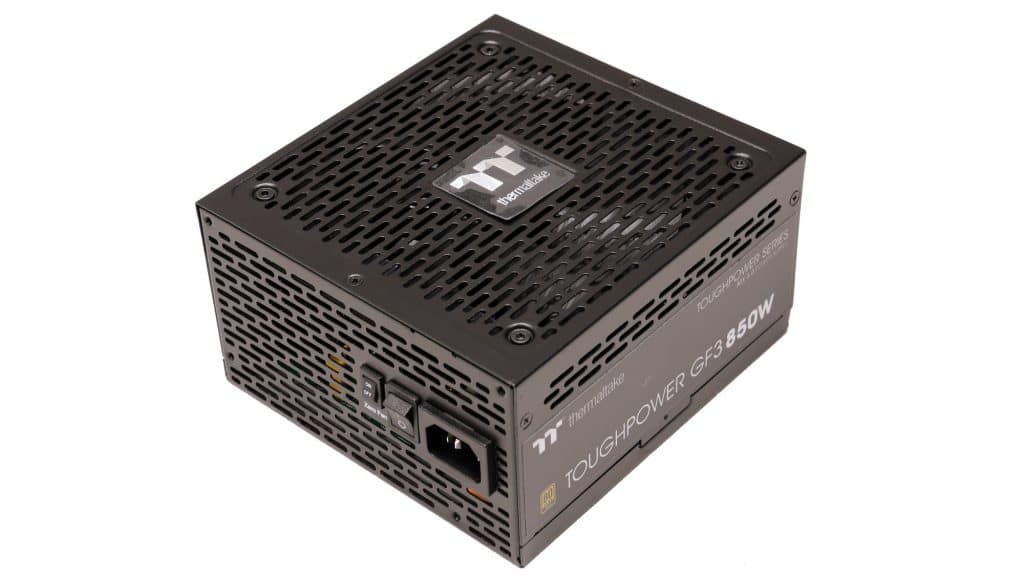
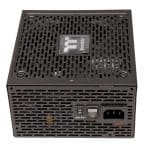
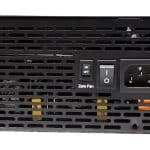
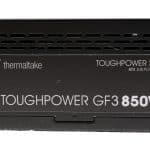
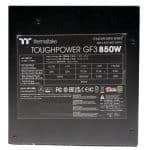
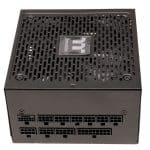


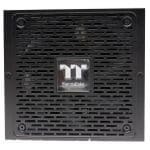
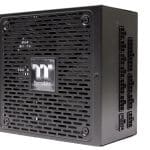
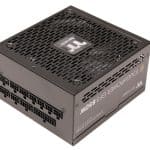
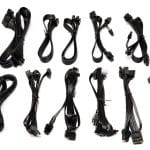
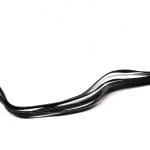



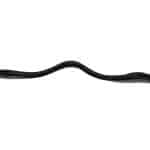
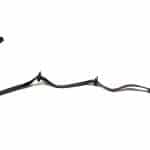


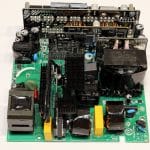


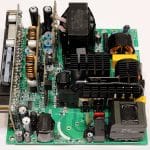
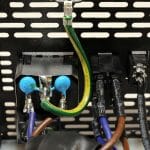
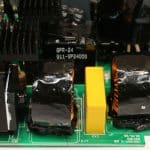
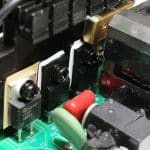
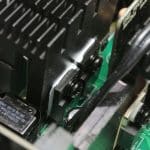


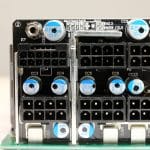
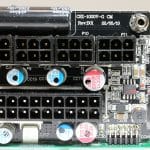

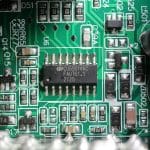
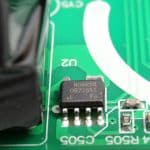
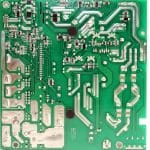


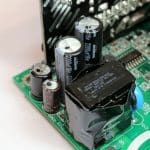

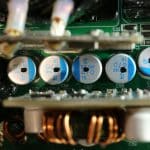
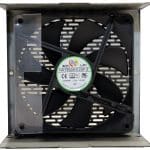

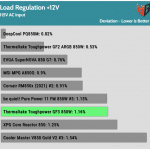
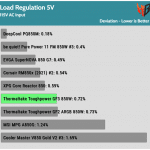
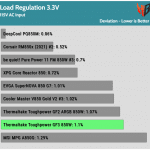
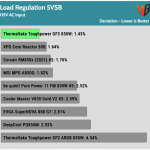
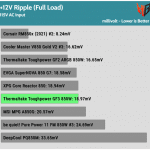
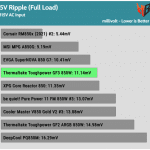
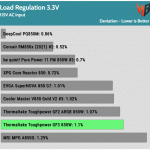

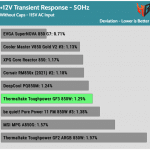

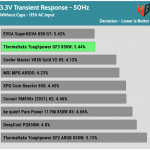
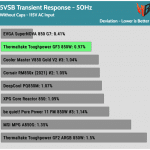
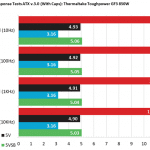
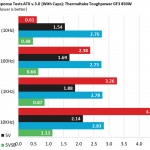

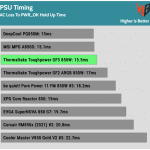
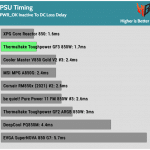

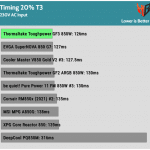
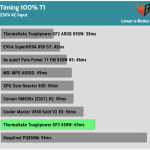

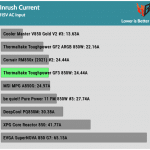
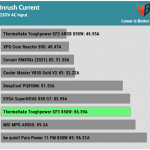
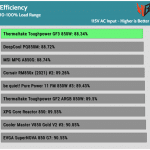
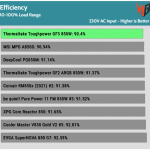
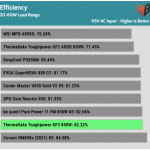
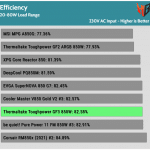
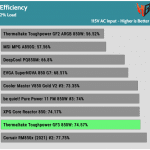
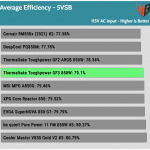
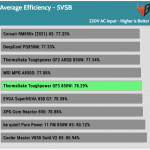
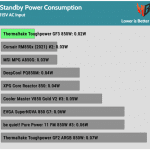
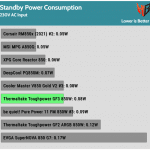
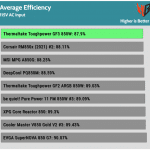
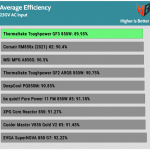
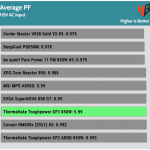
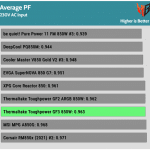
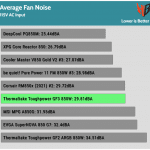
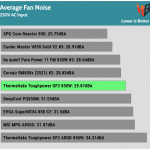


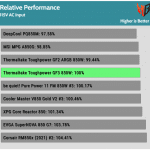
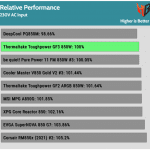
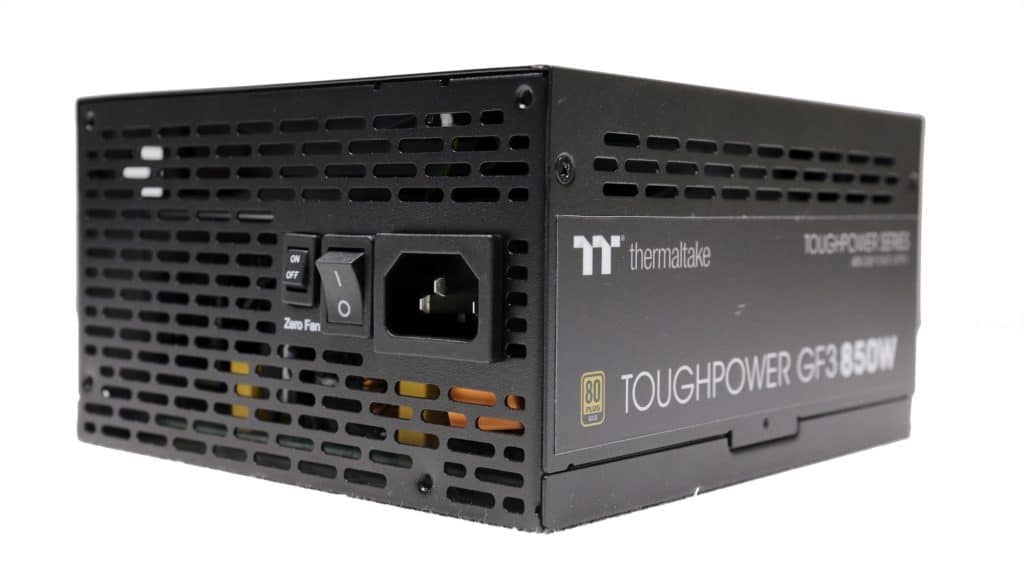


Hi Aris! I have been using this exact PSU for over a year now with an RX 7900 XT Sapphire Nitro+ (3x8pin connectors) but the PSU came only with 2×8 pin cables, so I have been using it with the pigtail of the second cable for the third connector. Haven’t had any problems yet but would it cause any problems in the long run? Thanks a lot in advance.
usually the third connector is under-utilized so I don’t believe you will have any issues under normal operating temperatures.
I am having a bit of trouble picking a power supply for my build with a Ryzen 7500f and 7900 GRE / XT (Europe).
Unless a lot changes I will probably stick with Radeon GPUs. Is ATX 3.0 still a good idea or not?
I’m considering the following:
Thermaltake GF3 850w (≈€110) (Is the efficiency something to worry much about?)
Adata XPG core reactor II 850w (≈€95) (I’m worried the thicker cables will be a problem in my case with barely 20mm cable room.)
Seasonic focus GX 850w ATX 2.4/3.0 (≈€120/140) (obviously good but Seasonic tax)
Corsair RMx 850w ATX 2.4 (≈€120) (Not much availability)
Maybe you can give me some deciding factors. Or would a 750w unit make more sense (accounting for future gpu upgrade)?
Thanks,
Oliver
Hi. I am NOT and expert, but I am starting to build with similar components (AMD 7500f and 7800xt graphics), and this unit, Thermalright GF3 850w, is rated top tier in the cultists PSU tier list. 750w may be enough but the difference in price is little (10-20 euros) and I think the added overhead capacity is a good idea. The ATX3.0 standard is also recommended because it implies better overall build quality and endurance. The other PSUs you listed seem good too, check the PSU cultist tier list and online reviews first.
I receive 2 GF3 850 both DOA waiting for 3rd from TT they will test befor sending, I hope it works, been waiting a week already so far a total od 2 weeks waiting for a good PSU.
Hi,
I’m using this Power Supply with my Zotac 4090 AMP Extreme AIRO, and even in 110% power mode (495w) with my 5900x in PBO, my Cyberpower UPS shows maximum 790w at the line, with no restarts so far. Is this because of ATX 3.0 allowing 200% loads, and the 12vhpwr cable allowing 600w even if it is labeled 300w? Also, is it safe to keep this, or better to upgrade to the 1200w model, even though your first test sample didn’t pass the ATX 2.0 200% load? Thanks in advance for your reply!
Ideally, I would suggest a 1000W PSU, but from the moment you don’t have restarts or any other system issues, you don’t need to replace your PSU.
Don’t trust what the UPS says, because it cannot catch power spikes.
Awesome, thanks for the reply! You are currently the best PSU reviewer out there IMHO 🙂
Hello,
Should i buy GF3 1300 or MSI MRG AI1300P, specially MSI is 100$ higher.
I haven’t yet completed the GF3 1350W review, but 100 dollars price difference is high!